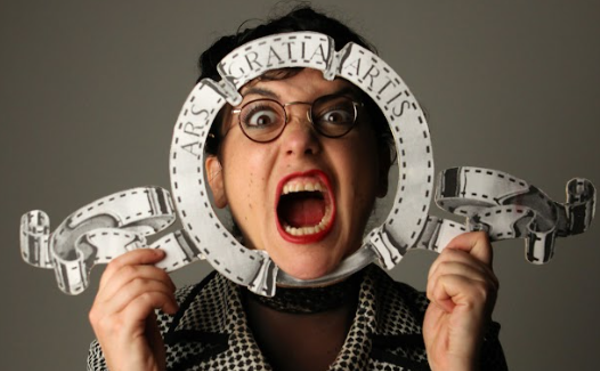"There's no city without graffiti," stated Blek Le Rat, the French artist who is arguably the godfather of stencil art. Heavily influenced by the New York City graffiti artists of the 1970s, Blek took the medium to a new level by using stencils to create commentaries on the quotidian life of the French. He famously spray-stenciled rats all over the city of Paris back in the early '80s to show that underneath her romantic facade teemed a wild society of rodents. Without Blek Le Rat, there might not be a Banksy and, perhaps then, no Humenrace — an artist whose work began to pop up a little more than a year ago all over Ohio City and its fringes.
Both graffiti and street art are such misunderstood genres. The underlying difference between graffiti art and street art is that graffiti is text based whereas street art is image based. Both languages, however, speak volumes about our permanent impermanence and the role we all play in our world. As a society we prefer art to be in a space where it's expected, where we can go to and admire it, not in our face where we're forced to talk about it.
"What Humenrace is doing is fine art. It's pristine and the messaging is awesome. Anonymity is intact," said Stamy Paul, the founder and president of GraffitiHeart, a singular nonprofit that promotes urban art in our city. "I love what he's bringing. It's unique to Cleveland and there's just such a nice job in the messaging, the detail, the quality. It really makes you pause. It's a different reaction. It's moving and causes action. You don't physically take action, though it definitely hits your cerebrum; it's not just your heart, but it goes right to your head too, so you're actually thinking it through."
The pieces are almost universally tinged with politics, whether the subject is war, climate change or America's current landscape.
Going one way down West Superior Road where the Detroit Superior Bridge ends in downtown, there are two children, dressed in orange prison jumpers, the word "illegal" stenciled across their chests as they play soccer with a ball and chain. This piece is strategically positioned at the foothill of the Carl B. Stokes Federal Courthouse. On West 25th Street near the intersection of Detroit Superior, another child in the same outfit holds a teddy bear. Her face looks up, her pigtails moving in the wind as she appears to be near tears. The latter was painted over within hours of its creation. In both cases, though, the artist is creating a forum for dialogue with the Northern Ohio District Federal Immigration Court that is housed within.
This work, however, is not the only message meant to jumpstart our synapses and raise questions. On Detroit and West 45th Street, Winnie the Pooh has met his demise by the hands of two adults holding shotguns. For sure this is a visual essay on gun violence and the mass shootings that seem to happen on a near-daily basis in this country. Here we see our childhood being hunted, shot down and promenaded before us like a trophy kill on some expensive and ruthless safari. The depiction of paradise lost is clear; the loss of innocence, the loss of childhood can't be denied.
More political inquiries are made with Humenrace's stencil of a First Nation chief with the words, "Is It Great Again Yet?" emblazoned next to him in bright neon green. On another wall Rev. Martin Luther King Jr. stands next to the same question. It's a very deep ask of the current person in office. We're reminded of the words of the late Nobel Prize winning writer Toni Morrison: "All good art is political! There is none that isn't. And the ones that try hard not to be political are political by saying, 'We love the status quo.' We've just dirtied the word 'politics,' made it sound like it's unpatriotic or something."
For some, finding the exact locations of Humenrace's work is almost a game. The artist, who doesn't speak on the record, posts their work on Instagram in vague locations, which encourages the public to seek it out.
One artist, who wished to remain anonymous, shared his opinion with us. "What I appreciate about Humenrace is that he's taking his work to the streets. In a time when murals and art installations are being governed more than ever and curated by those with economic influence, he chooses to sidestep that and creates on his own terms. The outcome is clean and pure. Hats off to anyone that's ever looked at a boring, gray space and thought, 'That would look better with some art there,' and then went and did something about it."
There are, of course, those who don't appreciate either the art itself or the way it's being done. Some in the graffiti community have mixed feelings. It's an unwritten no-no to put something over a piece of graffiti that's already up, and some we talked to thought Humenrace had violated that rule. So it's not surprising that some of these stencils have now been over-tagged. (It appears some of the stencils weren't over any existing graffiti but now, nonetheless, have been over-tagged as well, which could either be a retaliatory measure or a simple declaration that someone was, for some reason, unimpressed.)
The city of Cleveland declined to make anyone from the Department of Public Art available for an interview, which is a shame but par for the course. For the most part, Humenrace's pieces have remained where they were installed, with few building owners taking the steps to strip the work. And in the case of ICA–Art Conservation, whose door was a canvas for one Humenrace piece, they cut out the stencil when they needed to replace the door and will save and display it in the future (which, given their mission of art conservation, is very much on brand).
"Without question, this town needs more artistic activism, so I applaud the effort," said Mike Gutierrez, artist and owner of the 2020 West Schaaf Gallery + Studio. "But what does it say about the volume of public art and expression that one artist tossing up less than a dozen trendy issue stencils within the most gentrified community in Cleveland would even be a story?"
That point was mentioned by more than a few people during our conversations, and is one this writer had pondered as well.
You must ask the question, "Why is it important?" What hangs on the faded walls of our collective outdoor canvas is the writing on the wall: the politics of our time and what we did about it.
That's what will be remembered after civilization is gone.









